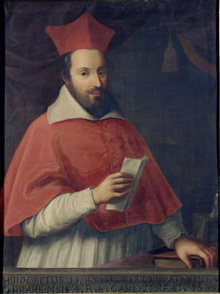Ippolito II d'Este
| Ippolito II d'Este | |
|---|---|

Ippolito II d'Este
|
|
| Noble family | House of Este |
| Father | Alfonso I d'Este |
| Mother | Lucrezia Borgia |
| Born |
25 August 1509 Ferrara, Italy |
| Died | 2 December 1572 (aged 63) |
| Occupation | Cardinal of Santa Maria in Aquiro |
Ippolito (II) d'Este (25 August 1509 – 2 December 1572) was an Italian cardinal and statesman. He was a member of the House of Este, and nephew of the other Ippolito d'Este, also a cardinal. He is perhaps best known for his despoliation of the then 1,400-year-old Hadrian's Villa, built by the Roman emperor Hadrian, removing marbles and statues from it to decorate his own villa, the Villa d'Este.
Ippolito was born in Ferrara, Italy, the second son of Duke Alfonso I d'Este and Lucrezia Borgia. His elder brother, Ercole II d'Este, succeeded his father as Duke of Ferrara in 1534. Through their mother, Ippolito and Ercole were grandsons of Pope Alexander VI. Ippolito himself is named after his uncle, Cardinal Ippolito d'Este.
In 1519, at the age of 10, he inherited the archbishopric of Milan from his uncle. This was the first of a long list of ecclesiastical benefices which Ippolito was given over time, the revenue from which was his main source of income. In addition to Milan, at the end of his life Ippolito also held the benefices of the sees/abbeys of Bondeno, Chaalis (1540–1572), Jumieges in Normandy, Lyon, Narbonne, and Saint-Médard in Soissons.
Ippolito d'Este was created Cardinal of Santa Maria in Aquiro by Pope Paul III in the consistory on 20 December 1538. He was only ordained a priest in 1564.
A lover of luxuries and magnificence, he overhauled the Palazzo San Francesco in Ferrara before his first appointment to the French court. After his elevation to the College of Cardinals in 1538, he refurbished the palace of his cousin, Cardinal Ercole Gonzaga, which he rented as his cardinalatial residence in Rome. He had the Villa d'Este built in Tivoli by Mannerist architect Pirro Ligorio, to match the other palaces he was building in Rome. To decorate his villa, he had much of the marbles and statues taken from the nearby ancient Hadrian's Villa, as a result of which the latter is devoid of most of its original features.
...
Wikipedia
